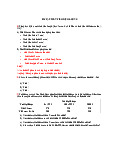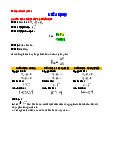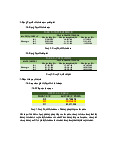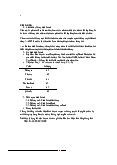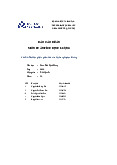




Preview text:
Advances in Economics, Business and Management Research, volume 142
5th Sriwijaya Economics, Accounting, and Business Conference (SEABC 2019)
The Nexus Between Operational Risk and
Profitability in Islamic Banking 1st Fida Muthia 2nd Reza Ghasarma 3r Sri d Andaiyani Department of Management Department of Management
Department of Economic Development Universitas Sriwijaya Universitas Sriwijaya Universitas Sriwijaya Inderalaya, Indonesia Inderalaya, Indonesia Inderalaya, Indonesia f.mutahi@unsri.ac.id r_ghasarma@unsri.ac.id andaiyanisri@gmail.com 4st Renaldi Setiawan Department of Accounting Universitas Sriwijaya Inderalaya, Indonesia renaldi.setiawan99@gmail.com
Abstract— This paper aims to demonstrate the effect of
banks. [6] explains that lack of the management practices
operational risk on profitability in Islamic banks. The total
in risk hedging may be one of the causes of the slow
of 14 Islamic banks in Indonesia for the period of 2016-2018
growth of Islamic banks. Therefore, it is important to
are selected to be the sample of this study. Operational risk is
analyse the effect of operational risk on the performance
measured using cost to income ratio and cost to total asset of Islamic banks.
ratio, meanwhile profitability is calculated by return on
average asset and return on average equity. Bank’s size,
Many researchers try to explore the relationship
which is measured by log of total asset, is used as the control
between operational risk on the performance of banks and
variable in this study. The findings show that the
yield different results. [7] examines the effect of
appropriate model in this study is Pooled OLS model and
operational risk on profitability of commercial banks in
operational risk, which is measured by cost to total asset, is
Kenya and found that it is negatively associated with bank
found to be positively related to profitability. This shows that
profitability. This result also supported by [5], [8]–[11],
the higher operational cost incurs by Islamic bank, the better
however, most of these research use conventional banks the management of their risk.
as their sample study. One study specifical y analyse the
impact of Islamic banks risk on profitability in 24
Keywords: operational risk, profitability, panel data, cost to
countries in 2015 and found that operational risk has
income ratio, cost to total asset ratio
negative effect on two profitability proxies, namely, return I. INTRODUCTION
on average asset (ROAA) and return on average equity
(ROAE). In contrast, study by [12] and [13] found a
With the growing interest in Islamic banking, the
positive association between operational risk and bank’s
effect of risk on Islamic banking has also received quiet
profitability using conventional banks as their sample
attention from scholars. In general, Basel committee
study. We believe that there is stil limited study that
recognizes at least four risks needed to be managed in investigates the relationship between operational risk and
banking system, namely, market risk, credit risk, liquidity
bank’s profitability, especially for Islamic banking.
risk and operational risk. Among other risks, operational
Therefore, this research wil try to extend the l tieratures
risk is considered to be more complex as it involves many that discuss the impact of operational risk on Islamic
aspects in an organization and also impacted by many banks’ profitability. Our sample study consists of 14
factors [1]. [2] mentions that operational risk is integral to
Islamic banks in Indonesia listed in Financial Services
al business process compared to credit risk or liquidity
Authority (OJK) for the period of 2016-2018. We use the
risk that are tend to be specific to one business area.
same proxies used by [14] in measuring both profita i b lity
Operational risk refers to the risks caused by the failed
and operational risk to demonstrate the impact of
internal process, people and systems [3]. In the case of independent variable on dependent variable.
Islamic banks, operational risk may also rises from the
The remaining of the paper is as fol ows. The data
possible losses as a result of sharia non-compliance and source, data col ection, variable measurement wil be
failure in fiduciary [4]. Scholars point out that the
explained in Methodology section. Results section wil
difference in nature between conventional a d n Islamic
present the empirical result of this study. The
banks caused their exposure to operational risks also interpretation of the results wil be discussed in the
differs [1]. [5] asserted that the complexity of contracts in
Analysis and Discussion section and Conclusion section
Islamic banks increase moral hazard that wil give impact wil conclude this study.
on the operational, credit and market performance of the
banks. The importance of managing operational risk in
Islamic banks has been highlighted by Ahmad et al (2009)
as cited in [2] that found operational risk to be the second
highest risk after credit risk in the operation of Islamic
Copyright © 2020 The Authors. Published by Atlantis Press SARL.
This is an open access article distributed under the CC BY-NC 4.0 license -http://creativecommons.org/licenses/by-nc/4.0/. 407
Advances in Economics, Business and Management Research, volume 142 II. LITERATURE REVIEW
ROAA and ROAE as the variable measurement for
profitability as we believe that it will give a more
[7] conducts a research on the effect of operational risk
comprehensive measurement. Meanwhile, for the
in commercial bank in Kenya using cost income ratio as
measurement of operational risk, we conclude that cost
the proxy for operational risk and return on equity (ROE)
income ratio is most used in measuring the risk and yield
for profitability. The study is done using 43 commercial
a negative effect. Moreover, when measured using banks in Kenya from 2005 – 2014 and found that
operating expenses to total asset ratio, some studies show
operational risk is negatively associated with bank
a positive association to profitability. Therefore, we use
profitability. This finding is similar to the findings by [11]
cost income ratio and operating expenses to total asset
that tries to investigate the effect of risks on bank’s
ratio as the proxy for operational risk. Our hypothesis
financial performance in Barbados. The study uses the development refers to the previous study conducted on the
same proxy as Murithi for measuring operational risk,
similar research, thus, we have at least four hypothesis in
which is cost income ratio. However, it uses return on
this study. The hypotheses are as follow:
asset (ROA) as a proxy for profitability.
H1a: There is a negative impact of cost income ratio (OCI)
Another research is done by [5] in Ghana that tries to on ROAA
demonstrate the impact of credit and operational risks on H1b: There is a negative impact of cost income ratio (OCI)
bank’s financial performance. Different to other studies,
this research uses bank leverage to measure the on ROAE
operational risk and ROA as well as net income margin
H1c: There is a positive impact of operating expenses to
(NIM) as the proxy of profitability. By using 24 samples
total asset ratio (OCTA) on ROAA
of universal banks, the study shows that operational risk H1d: There is a positive impact of operating expenses to
has a positive effect on financial performance. [8] also
total asset ratio (OCTA) on ROAE
conducts a similar study but using primary data to
measure the effect of operational risk on the III. METHODOLOGY
organizational performance of banks in Nigeria. This A. Profitability
study also yields a similar result that operational risk is
Profitability refers to the ability of the company to
indeed is negatively associated with organizational performance.
generate profit for a certain period. Studies on bank’s
profitability generally use return on asset (ROA) and
In terms of related research on Islamic banks, [9] uses return on equity (ROE) to measure this variable [5], [7]–
11 Islamic banks in Gulf Cooperation Council regions to
[9], [11]–[13]. In this study, profitability is measurement
see the relationship between operational risk and using two proxies, return on average asset (ROAA) and
profitability. This study uses cost income ratio as the
return on average equity (ROAE). We refer these
measurement for operational risk and ROA as well as
measurements based on the study conducted by [14], in
ROE as the proxies for profitability. The study shows that
which ROAA is the ratio of net profit before taxes divided
operational risk has negative effect on profitability for
by average asset and ROAE is the ratio of net profit
both measurements (ROA and ROE).
before taxes divided by average equity.
Furthermore, [14] conducts a study on 75 Islamic B. Operational Risk
banks in 24 countries in 2015 to see the effect of credit
According to [3], operational risk in Islamic banks
risk, insolvency risk, liquidity risk and operational risk on
refers to those risk arises from inadequate or failed
bank’s profitability. It uses two proxies for operational
internal and external business processes that may be
risk, namely, cost income ratio and operation expenses to caused by the people or the system and also as a result on
total equity ratio. It also uses two measurements to shariah non-compliance and fiduciary. Two ratios have
calculate bank’s profitability, which is return on average
been widely used in measuring operational risk, namely,
asset (ROAA) and return on average equity (R AE O
). The cost income ratio and operating expenses to total equity
findings show that operational risk also has a negative ratio. Studies that used cost income ratio as the proxy of effect on profitability.
operational risk, usually find a negative association
However, similar study using similar proxies
between operational risk and profitability (source).
conducted by [12] in Tunisia show a different result. The
However, when operating expenses to total asset ratio is
study tries to investigate the determinants of Tunisian
used, some studies found a positive link to profitability.
banking industry using data from 1980 to 2000. It uses
This study uses both measurements to calculate
operation expenses to total equity ratio as the proxy for operational risk. We divide operational costs by
operational risk and shows that it has a positive
comprehensive income (OCI) in calculating cost income
association with bank’s profitability. This finding also
ratio and we compare operational costs by total asset
supported by the study of [13] that examine the
(OCTA) to measure the operating expenses to total equity
determinants of banks profitability in Macau. Using data
ratio. Both measurements are also used by [14] in their
from commercial banks in 1993 to 2007, it shows that
study. Therefore, the hypothesis of this study is as
expense management variable as the proxy of operational follows:
risk has a positive association with profitability.
By looking at the results of the previous research, we
decided to demonstrate the effect of operational risks on
bank profitability. In measuring the profitability we uses
two common proxies that are used, namely ROA and
ROE. However, we follow the research by [14] that uses 408
Advances in Economics, Business and Management Research, volume 142
OLS, OCTA and Size also shows its significant effect on
ROAA with 1% and 10% significance. OCTA and Size TABLE I. VARIABLE DEFINITION
shows a positive magnitude on profitability showing that Variable Measurement Notation
the increase in each variable will increase the profitability Profitability Net profit before ROAA
of banks. Moreover, rho shows the proportion of variation taxes/ average asset
caused by individual specific term; in this case, the rho Net profit before ROAE taxes/ average
shows the value 27.929 % indicating that the effect on equity
ROAA can be explained by OCTA and Size as much as Operational Risk Operational cost/ OCI 27.929%. comprehensive income
TABLE III. REGRESSION RESULTS O F R ROAA Operational cost/ OCTA total asset ROAA Pooled OLS Fixed Effect Random Effect Size Log(Total Asset) LgTA OCI -2.17x106 -5.5x108 8.7x107 (-0.09) (-0.00) (0.04)
Table 1 presents the variable definition used in this OCTA 0.648* 0.630 0.606* (4.49) (1.10) (3.43)
study. Profitability as the dependent variable is measured Size 0.022** 0.162 0.0239***
using two proxies, ROAA (Return On Average Asset) and (2.08) (1.44) (1.74)
ROAE (Return on Average Equity). Meanwhile, R2 0.3707
operational risk is the independent variable in this study R2 Within 0.084 0.0091
and measured using, OCI (Cost Income Ratio) and OCTA R2 0.1729 0.5716
(Operating Expenses to Total Equity). This study also Between
uses the size of the company as control variable, which is R2 Overall 0.1225 0.3692 measured by log total asset. Sigma u 0.0795 0.0195 Sigma e 0.0314 0.0314
The total of 14 Islamic commercial banks in Indonesia Rho 0.8648 0.27929
are used in this study. We collect the data based on the Hausman Test 0.2474
Breusch-Pagan Lagrange Multiplier 0.1467
number of Islamic banks listed in OJK from 2016 to 2018.
Note: * refers to significance level of 1%, ** refers to significance level of 5% and
Therefore, all 14 Islamic banks are used as the sample of *** refers to significance level of 10%
this study. In analysing the data, panel data regression
Furthermore, Hausman test and Breusch-Pagan
analysis is used with the following model:
Lagrange Multiplier test are conducted to choose the ROAA
appropriate model for the panel data. Hausman test is
i,t= ao +a1OCIi,t + a2OCTAi,t + LgTAi,t + ei,t (1)
conducted to choose between Fixed Effect model and
ROAEi,t= ao +a1OCIi,t + a2OCTAi,t + LgTAi,t + ei,t (2)
Random Effect model and the value of the test shows ROAA
0.2474 indicating that fixed effect model is not
i,t refers to return on average asset for bank i for the year t, ROAE
appropriate for this panel data. Further, Breusch-Pagan
i,t is return on average equity for bank i for the year t, OCI
Lagrange Multiplier (LM test) is done to choose between
i,t and OCTAi,t represent the operational
risk for bank i for the year t, LgTA
Pooled OLS and Random Effect model, the result shows i,t refers to the size of
the bank i for the year t and e
that LM test is not significant (0.1467>0.05) which can be i t is an error term.
concluded that Pooled OLS is the most appropriate model IV. RESULTS
for this panel data. The regression result for ROAA shows
that Pooled OLS is the most appropriate model and
Table 2 represents descriptive statistics for all
variables that affecting ROAA are OCTA and Size with
variables for all 14 banks. It can be seen that Islamic
positive magnitude. Therefore, H
banks have quiet low profitability measured by ROAA 1a and H1b are rejected but H
(0.6%) and ROAE (2.8%). However, the variation in
1c and H1d are supported by the findings. The
profitability between banks is relatively small, 4.3% and
coefficient of determination for this model in Pooled OLS
28.8% measured by ROAA and ROAE, respectively.
is 37.07%, which means that OCTA and Size can explain
ROAA only for 37.07% and the rest is explained by other variables outside the model. TABLE II. DESCRIPTIVE T S ATISTICS Variable Mean Std. Dev Min Max ROAA 0.00656 0.043759 -0.1121285 0.1225733 ROAE 0.028010 0.2885258 -0.1333394 0.4723746 OCI 47.153 227.879 -14.545 1463,337 OCTA 0.05537 0.0393 0.0135406 0.1892902 Size 13,0337 0.526796 11.8208 13.992 N=42 n=14 T=3 A. Regression Results
Table 3 shows the regression result for variable ROAA
and ROAE. The test conducted for Pooled OLS, Fixed
Effect and Random Effect model. In Panel A, it can be
seen that, OCTA and Size shows a significant effect on
ROAA, with 1% and 5% significance, respectively in
Pooled OLS. Furthermore, in Fixed Effect model, none of
the variables are found to be significant. Similar to Pooled 409
Advances in Economics, Business and Management Research, volume 142
used in measuring operational risk may show a different TABLE IV. REGRESSION RESULTS O F R ROAE
meaning. We found that cost to total asset ratio (OCTA) is ROAE Pooled OLS Fixed Effect Random Effect
significant in affecting profitability and the positive OCI 6.78x106 -9.64x106 0.000031
magnitude show that bank’s overhead cost is passed on its (0.04) (-0.04) (0.07)
depositors and lenders [12]. Furthermore, OCTA also OCTA 3.079* 1.406 2.953 (2.88) (0.31) (2.58)**
shows that how well bank manage its assets and liabilities Size 0.1339*** 0.262 0.1358
in order to successfully manage their risk [15]. This (1.68) (0.29) (1,12)
assumes that the higher operational costs, the bank bears, R2 0.2089
the better the bank manage their risk, therefore, it will R2 Within 0.005 0.0022 increase its profitability. R2 0.2035 0.3973 Between
In terms of control variable, we found that size has R2 Overall 0.1115 0.2088
positive and significant effect on bank’s profitability. This Sigma u 0.19928 0.1255
finding is in consistent with the finding by [14] and Sigma e 0.250567 0.25056
consistent with [16] that greater size of assets contribute Rho 0.38746 0.20059
to higher profitability (measured by both ROAA and Hausman Test 0.8186
Breusch-Pagan Lagrange Multiplier 0.2302 ROAE).
Note: * refers to significance level of 1%, ** refers to significance level of 5% and
*** refers to significance level of 10% VI. CONCLUSION
Table 4 shows the regression result for ROAE. Similar
This study examines the effect of operational cost on
with the results for ROAA, in Pooled OLS, OCTA and
profitability of Islamic banks in Indonesia. The
Size are found to be significant on ROAE with
operational cost is measured using cost to income ratio
significance level of 1% and 10%, respectively. In Fixed
(OCI) and cost to total asset ratio (OCTA), while
Effect model, none of the variables are found to be
profitability is calculated using return on average asset
significant on ROAE, which is similar to the findings of
(ROAA) and return on average equity (ROAE). The
ROAA. Lastly, in Random Effect model, only OCTA is
findings show that operational risk that is measured by
found to be significant on ROAE. In selecting the most
OCTA is found to be positively significant in affecting
appropriate model, Hausman test and LM test are bank’s profitability. This indicates that the higher
conducted. Based on the results of both test, it can be operational risks the bank has, the higher the profitability
concluded that Pooled OLS is the most appropriate model it will yield which also means that the manages its
for this panel data, in which both test yield insignificant
operational risk very well that it increases its profitability.
value, 0.8186 and 0.2302 (>0.005) for Hausman test and
LM test, respectively. Based on the hypothesis, it can be REFERENCES
concluded that H1a and H1b are rejected and H1c and H1d [1] O. O. Ebenezer, A. Islam, W. S. Yusoff, and Z. Shamsuddin, “An
are supported. Furthermore, based on the coefficient of
Investigation Into Operational Risk in Commercial Banks:
determination, it can be seen that OCTA and Size can
Empirical Evidence from Nigeria,” Int. J. Accounting, Financ.
Bus., vol. 3, no. 12, pp. 49–62, 2018.
only explain ROAE for 20.89%, in which the rest 79.11%
is explained by other variables outside the model
[2] M. Abdullah, S. Shahimi, and A. G. Ismail, “Operational risk in
Islamic banks : examination of issues,” Qual. Res. Financ. Mark.,
Therefore, based on the regression results for both
vol. 3, no. 2, pp. 131 151, 201 – 1.
variables (ROAA and ROAE), Pooled OLS is the most
[3] BCBS, “Working Paper on The Regulatory Treatment of
appropriate model for the panel data and OCTA and Size Operational Risk,” 2001.
are found to have a significant effect on ROAA and ROAE.
[4] I. Akkizidis and S. K. Khandelwal, Financial Risk Management for
Islamic Banking and Finance. London: Palgrave Macmillan, 2008. V. ANALYSIS AND DISCUSSION
[5] S. G. Gadzo, H. K. Kportorgbi, and J. G. Gatsi, “Credit risk and
operational risk on financial performance of universal banks in
The results of data analysis show that cost to total
Ghana : A partial least squared structural equation model ( PLS
asset ratio (OCTA) has a positive and significant effect on
SEM ) approach,” Cogent Econ. Financ., vol. 7, no. 1, pp. 1 16, –
both proxies of profitability. However, cost to income 2019.
ratio is found to be insignificant for both ROAA and
[6] M. Y. A. Basah, S. N. A. Mohamad, M. R. Ab. Aziz, K. F. Kahiri,
ROAE. This finding is differ to the findings found by [5],
N. H. Laili, H. Sabri, and M. Md Yusuf, “Risk in Islamic Banks: [7] [9], –
[11], [14] that find negative correlation between
Challenges and Management,” J. Eng. Appl. Sci., vol. 13, no. 8, p.
operational risk and profitability. Their findings show that 2081=2085, 2018.
the higher operational cost, the less profitability will be
[7] J. G. Muriithi and R. G. Muigai, “Quantitative analysis of
yield by Islamic banks. This indicates that losses arises
Operational Risk and Profitability of Kenyan Commercial Banks
from bank’s operation may lead to an increase in
using Cost Income Ratio,” J. Econ. Financ., vol. 8, no. 3, pp. 76– 83, 2017.
operational cost; hence it will decrease bank’s profitability.
[8] M. N. Okeke, C. U. Aganoke, and A. N. Onuorah, “Operational
Risk Management and Organizational Performance of Banks in ,
Surprisingly, our findings on operational risk and
Edo State Operational Risk Management and Organizational
profitability present different results than those previous
Performance of Banks in , Edo State,” Int. J. Acad. Res. Econ.
study as operational risk is found to have a positive
Manag. Sci., vol. 7, no. 4, pp. 103 120, 2018. –
relation to profitability showing that the increase in
[9] H. A. H. Al-tamimi, H. Miniaoui, and W. W. Elkelish, “Financial
operational risk will increase bank’s profitability. This
risk and islamic banks’ performance in the gulf cooperation council
finding is in line with the findings by [12], [13] that
countries,” Int. J. Bus. Fianance Res., vol. 9, no. 5, pp. 103–112,
conclude the same result. Our argument is that the proxy 2015. 410
Advances in Economics, Business and Management Research, volume 142
[10] P. Suseno and O. Bamahriz,
“Economic Journal of Emerging
[14] P. Suseno and O. Bamahriz, “Examining The Impact of Bank’s
Markets,” vol. 9, no. October, pp. 125–137, 2017.
Risks to Islamic Bank’s Profitability,” Econ. J. Emerg. Mark., vol. 9, no. 2, pp. 125 137, 2017. –
[11] A. Wood and S. Mcconney, “The Impact of Risk Factors on The
Financial Performance of The Commercial Banking Sector in
[15] K. Ali, M. F. Akhtar, and S. Sadaqat, “Financial and Non-Financial
Barbados,” J. Gov. Regul., vol. 7, no. 1, 2018.
Business Risk Perspectives Empi –
rical Evidence from Commercial
Banks,” Middle East. Financ. Econ., vol. 11, no. 11, 2011.
[12] S. Ben Naceur, A. Barajas, and A. Massara, “Can islamic banking
increase financial inclusion ?,” IMF Work. Pap., pp. 1–41, 2015.
[16] O. Masood, M. Ashraf, and S. Turen, “Bank-Specific and
Macroeconomic Determinants of Bank Profitability : Evidence
[13] A. P. I. Vong and H. S. Chan, “Determinants of Bank Profitability
from Member States of the OIC,” J. Islam. Financ. Stud., vol. 1, in Macao,” pp. 93–113. no. 1, 2015. 411
